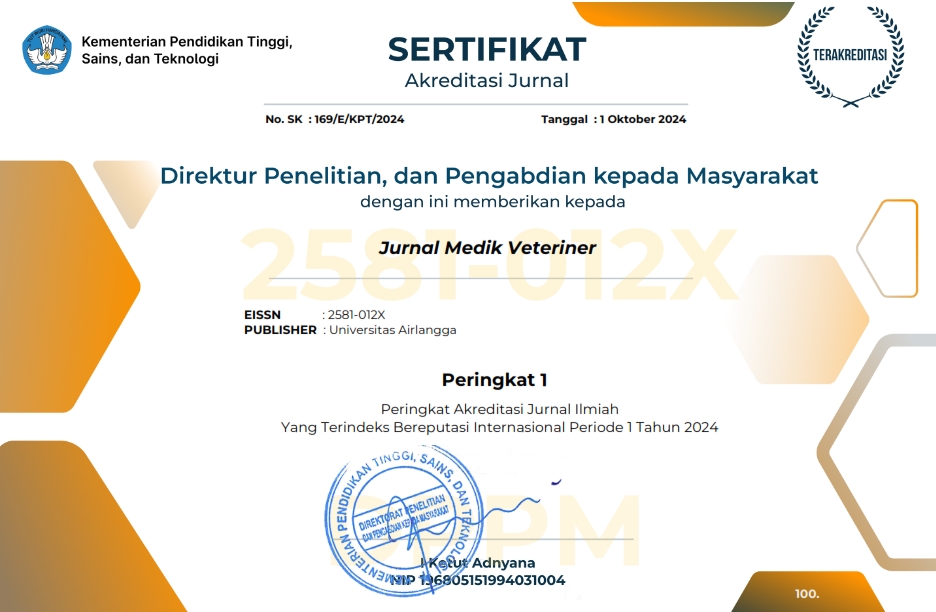Prevalence and Associated Risk Factors of Bovine Viral Diarrhoea (BVD) in Ruminants in Selangor

Downloads
Bovine Viral Diarrhoea (BVD) is caused by pestivirus, which has an economic impact on the ruminant industry. Most study focuses on cattle as the most affected species having detrimental effects on the reproductive soundness. However, the role of small ruminants in BVD transmission requires further understanding as they can also be affected by BVD. Thus, a cross-sectional study was carried out in Selangor with an objective (1) to determine the seroprevalence of BVD in cattle, deer, sheep, and goats and (2) to identify the associated risk factors of BVD. A total of 596 healthy animals i.e., 176 cattle, 212 goats, 100 sheep and 108 deers were randomly selected and sampled between 2021 to 2024 in 19 selected farms in Selangor. Blood samples were collected from all of the animals and the serum samples were tested against the detection of antibodies against p80-125 protein (NSP2-3), a non-structural protein (NS3), highly conserved, and common to all strains of pestiviruses such as BVD, Border Disease (BD), and BVD-Antigen using a specific monoclonal antibody (Erns). The risk factors were analysed by running a univariate and multivariate logistic regression model compiled using a backward-selection procedure analysis to obtain the odds ratio (OR). This study found that the herds seroprevalence of BVD among the farms was 57.89% (n = 19). Cattle seroprevalence is 29.54% (n = 176), goats 11.3% (n = 212), sheep at 50% (n = 100), and deer at 0% (n = 108). Only one breeding ram was tested positive for the BVD-Antigen test. The key risk factors for BVD in cattle included being dairy cattle (OR = 12.60, p < 0.001), lactating (OR = 31.2, p < 0.001), raised in semi-intensive systems (OR = 106.08, p < 0.001), kept in cattle-only herds (OR = 26.32, p < 0.002), and being located in urban areas (OR = 191.95, p < 0.001). For small ruminants, significant risk factors included goats raised in intensive systems (OR = 6.73, p < 0.001) and female sheep (OR = 2.25, p = 0.047). The findings highlights that BVD seroprevalence in sheep and goats in Selangor, identifying a positive BVD antigen result in a breeding ram, emphasizing the sheep's role in BVD transmission. In short, the multi-species ruminant farming in Malaysia should be cautioned for the risk of BVD transmission.
Ahasan, M. S., Rahman, M. S., Rahman, A. K. M. A., & Berkvens, D. (2016). Bovine and caprine brucellosis in Bangladesh: Bayesian evaluation of four serological tests, true prevalence, and associated risk factors in household animals. Tropical Animal Health and Production, 49(1), 1–11.
Ames, T. (2008). Hosts. In: Bovine Viral Diarrhea Virus Diagnosis, Management and Control, Goyal S. M. & Ridpath J. F. Blackwell Publishing, pp. 171–176.
Arnaiz, I., Cerviño, M., Martínez, S., Fouz, R., & Diéguez, F. J. (2021). Bovine viral diarrhea virus (BVDV) infection: Effect on reproductive performance and milk yield in dairy herds. The Veterinary Journal, 277(2021), 105747.
Azari, M., Billa, L., & Chan, A. (2022). Multi-temporal analysis of past and future land cover change in the highly urbanized state of Selangor, Malaysia. Ecological Processes, 11(1), 1–15.
Bachofen, C., Vogt, H. R., Stalder, H., Mathys, T., Zanoni, R., Hilbe, Schweizer, M. & Peterhans, E. (2013). Persistent infections after natural transmission of bovine viral diarrhoea virus from cattle to goats and among goats. Veterinary Research, 44(1), 1–10.
Broaddus, C. C., Lamm, C. G., Kapil, S., Dawson, L., & Holyoak, G. R. (2009). Bovine viral diarrhea virus abortion in goats housed with persistently infected cattle. Veterinary Pathology, 46(1), 45–53.
Bulut, H., Sozdutmaz, I., Pestil, Z., Abayli, H., Sait, A., & Cevik, A. (2018). High prevalence of bovine viral diarrhea virus-1 in sheep abortion samples with pestivirus infection in Turkey. Pakistan Veterinary Journal, 38(1), 71–75.
Cantu, A., Ortega-S, J. A., Mosqueda, J., Garcia-Vazquez, Z., Henke, S. E., & George, J. E. (2008). Prevalence of infectious agents in free-ranging white-tailed deer in northeastern Mexico. Journal of Wildlife Diseases, 44(4), 1002–1007.
Chase, C. C., Braun, L. J., Leslie-Steen, P., Graham, T., Miskimins, D., & Ridpath, J. F. (2008). Bovine viral diarrhea virus multiorgan infection in two white-tailed deer in southeastern South Dakota. Journal of Wildlife Diseases, 44(3), 753–759.
Daves, L., Yimer, N., Arshad, S. S., Sarsaifi, K., Omar, M. A., Yusoff, R., & Abdullah, F. F. J. (2016). Seroprevalence of bovine viral diarrhea virus (BVDV) infection and associated risk factors in cattle in Selangor, Malaysia. Veterinary Medicine Open Journal, 1, 22–28.
Demil, E., Fentie, T., Vidal, G., Jackson, W., Lane, J., Mekonnen, S. A., & Smith, W. (2021). Prevalence of bovine viral diarrhea virus antibodies and risk factors in dairy cattle in Gondar city, Northwest Ethiopia. Preventive Veterinary Medicine, 191, 105363.
Deng, M., Ji, S., Fei, W., Raza, S., He, C., Chen, Y., & Guo, A. (2015). Prevalence study and genetic typing of bovine viral diarrhea virus (BVDV) in four bovine species in China. PLOS ONE, 10(4), 1–16.
Department of Statistics Malaysia (2024). The Population of Malaysia. Retrieved from https://open.dosm.gov.my/dashboard/population/sgr on 25 October 2024.
Department of Veterinary Services Selangor (DVS) (2020). Annual Report. Retrieved from https://dvssel.gov.my/en/laporan-tahunan/ on 25 October 2024.
Department of Veterinary Services Selangor (DVS) (2021). Annual Report. Retrieved from https://dvssel.gov.my/en/laporan-tahunan/ on 25 October 2024.
Department of Veterinary Services Selangor (DVS). (2023). Statistics 2022/2023. Retrieved from https://www.dvs.gov.my/index.php/pages/view/4564 on 25 October 2024.
Diao, N. C., Chen, Z. Y., Shi, J. F., Wang, Q., Sheng C. Y., Ma, B. Y.. Yang, Y., Sun, Y. H., Shi K., & Du R. (2021). Prevalence of bovine viral diarrhea virus in ovine and caprine flocks: a global systematic review and meta-analysis. Frontiers in Veterinary Science, 8(2021), 1–14.
Evans, C. A., Lanyon, S. R., O’Handley, R. M., Reichel, M. P., & Cockcroft, P. D. (2018). Seroprevalence of antibodies to Pestivirus infections in South Australian sheep flocks. Australian Veterinary Journal, 96(8), 312–314.
Evans, C., Han, J. H., Weston, J., Heuer, C., & Gates, M. (2019). Serological evidence for exposure to bovine viral diarrhoea virus in sheep co-grazed with beef cattle in New Zealand. New Zealand Veterinary Journal, 68(4), 238–241.
Fitri, W. N., Haron, A. W., Hj Yusoff, R., Abdullah, F. F. J., Abidin, S. A. S. Z., Lila, M. A. M., Amat, A. C., Rashid, M. A., & Omar, M. A. (2017). Determination of breeding seasonality in rusa deer (Rusa timorensis) stags via serum testosterone profiling. American Journal of Animal and Veterinary Sciences, 12(1), 45–52.
Hanon, J. B., De Baere, M., De la Ferté, C., Roelandt, S., Van der Stede, Y., & Cay, B. (2017). Evaluation of 16 commercial antibody ELISAs for the detection of bovine viral diarrhea virus–specific antibodies in serum and milk using well-characterized sample panels. Journal of Veterinary Diagnostic Investigation, 29(6), 833–843.
Hidayat, W., Wuryastuty, H., & Wasito, R. (2021). Detection of Pestivirus in small ruminants in central Java, Indonesia. Veterinary World, 14(4), 996–1001.
Houe, H. (2003). Economic impact of BVDV infection in dairies. Biologicals, 31(2), 137–143.
Huaman, J. L., Pacioni, C., Forsyth, D. M., Pople, A., Hampton, J. O., Carvalho, T. G., & Helbig, K. J. (2020). Serosurveillance and molecular investigation of wild deer in Australia reveals seroprevalence of Pestivirus infection. Viruses, 12(7), 752.
Jokar, M., Rahmanian, V., Farhoodi, M., Abdous, A., Shams, F., & Karami, N. (2021). Seroprevalence of bovine viral diarrhea virus (BVDV) infection in cattle population in Iran: a systematic review and meta-analysis. Tropical Animal Health and Production, 53(5), 1–12.
Khalid, N., Arshad, S. S., Degu, N. Y., Ramanoon, S. Z., & Sadiq, M. B. (2024). Molecular detection and genotyping of bovine viral diarrhea virus in Selangor, Malaysia. Journal of Advanced Veterinary and Animal Research, 11(2), 474.
Krametter-Froetscher, R., Duenser, M., Preyler, B., Theiner, A., Benetka, V., Moestl, K., & Baumgartner, W. (2010). Pestivirus infection in sheep and goats in West Austria. The Veterinary Journal, 186(3), 342–346.
Krametter‐Froetscher, R., Loitsch, A., Kohler, H., Schleiner, A., Schiefer, P., Moestl, K., & Baumgartner, W. (2006). Prevalence of antibodies to pestiviruses in goats in Austria. Journal of Veterinary Medicine, Series B, 53(1), 48–50.
Kumar, S. K., Palanivel, K. M., Sukumar, K., Ronald, B., Selvaraju, G., & Ponnudurai, G. (2018). Herd-level risk factors for bovine viral diarrhea infection in cattle of Tamil Nadu. Tropical Animal Health and Production, 50(4), 793–799.
Lanyon, S. R., Anderson, M. L., Bergman, E., & Reichel, M. P. (2013). Validation and evaluation of a commercially available ELISA for the detection of antibodies specific to bovine viral diarrhoea virus (bovine pestivirus). Australian Veterinary Journal, 91(1–2), 52–56.
Lanyon, S. R., Hill, F. I., Reichel, M. P., & Brownlie, J. (2014). Bovine viral diarrhoea: pathogenesis and diagnosis. The Veterinary Journal, 199(2), 201–209.
Mishra, N., Rajukumar, K., Tiwari, A., Nema, R. K., Behera, S. P., Satav, J. S., & Dubey, S. C. (2009). Prevalence of Bovine viral diarrhoea virus (BVDV) antibodies among sheep and goats in India. Tropical Animal Health and Production, 41, 1231–1239.
Moeller, R. B. (2012). Disorders of sheep and goats. Kirkbride’s diagnosis of abortion and neonatal loss in animals, 4, 49–87.
Naing, L., Nordin, R.B., Abdul Rahman, H. (2022). Sample size calculation for prevalence studies using Scalex and ScalaR calculators. BMC Medical Research Methodology, 22, 209.
Nelson, D. D., Duprau, J. L., Wolff, P. L., & Evermann, J. F. (2016). Persistent bovine viral diarrhea virus infection in domestic and wild small ruminants and camelids including the mountain goat (Oreamnos americanus). Frontiers in Microbiology, 6, 1415.
Nugroho, W., Silitonga, R. J. P., Reichel, M. P., Irianingsih, S. H., & Wicaksono, M. S. (2022). The epidemiology and control of bovine viral diarrhoea virus in tropical Indonesian cattle. Pathogens, 11(2), 215.
Partida, E. L., Fernández, M., Gutiérrez, J., Esnal, A., Benavides, J., Pérez, V., de la Torre, A., Alvarez, M. & Esperón, F. (2017). Detection of bovine viral diarrhoea virus 2 as the cause of abortion outbreaks on commercial sheep flocks. Transboundary and Emerging Diseases, 64(1), 19–26.
Passler, T., Ditchkoff, S. S., & Walz, P. H. (2016). Bovine viral diarrhea virus (BVDV) in white-tailed deer (Odocoileus virginianus). Frontiers in Microbiology, 7, 1–11.
Patel, K. K., Stanislawek, W. L., Burrows, E., Heuer, C., Asher, G. W., Wilson, P. R., & Howe, L. (2019). Investigation of association between bovine viral diarrhoea virus and cervid herpesvirus type-1, and abortion in New Zealand farmed deer. Veterinary Microbiology, 228, 1–6.
Pecora, A., Aguirreburualde, M. P., Rodriguez, D., Seki, C., Levy, M. S., Bochoeyer, D., & Wigdorovitz, A. (2009). Development and validation of an ELISA for quantitation of bovine viral diarrhea virus antigen in the critical stages of vaccine production. Journal of Virological Methods, 162(1–2), 170–178.
Purnama, M. T. E., Dewi, W. K., Prayoga, S. F., Triana, N. M., Aji, B. S. P., Fikri, F., & Hamid, I. S. (2019). Preslaughter stress in banyuwangi cattle during transport. Indian Veterinary Journal, 96(12), 50–52.
Retno, N., Wuryastuty, H., Wasito, R., & Irianingsih, S. H. (2022). First study on genetic variability of bovine viral diarrhea virus isolated from Sapera dairy goats with reproductive disorders in Yogyakarta, Indonesia. Veterinary World, 15(4), 1015–1021.
Ridpath, J. F., Driskell, E. A., Chase, C. C., Neill, J. D., Palmer, M. V., & Brodersen, B. W. (2008). Reproductive tract disease associated with inoculation of pregnant white-tailed deer with bovine viral diarrhea virus. American Journal of Veterinary Research, 69(12), 1630–1636.
Ridpath, J. F., Mark, C. S., Chase, C. C., Ridpath, A. C., & Neill, J. D. (2007). Febrile response and decrease in circulating lymphocytes following acute infection of white-tailed deer fawns with either a BVDV1 or a BVDV2 strain. Journal of Wildlife Diseases, 43(4), 653–659.
Sa’bani, B., Hermansyah, B., Sofiana, K. D., Armiyanti, Y., & Utami, W. S. (2024). Risk Factor Analysis of Cryptosporidium sp. Contamination in Dairy Cow Milk in Jember, Indonesia. Jurnal Medik Veteriner, 7(1), 177–186.
Sarrazin, S., Veldhuis, A., Méroc, E., Vangeel, I., Laureyns, J., Dewulf, J., Caij, A. B., Piepers, S., Hooyberghs, J., Ribbens, S., & van der Stede, Y. (2013). Serological and virological BVDV prevalence and risk factor analysis for herds to be BVDV seropositive in Belgian cattle herds. Preventive Veterinary Medicine, 108(1), 28–37.
Silveira, S., Falkenberg, S. M., Elderbrook, M. J., Sondgeroth, K. S., Dassanayake, R. P., Neill, J. D., Ridpath, J. F. & Canal, C. W. (2018). Serological survey for antibodies against pestiviruses in Wyoming domestic sheep. Veterinary Microbiology, 219, 96–99.
Sohel A., Julio D. Dávila, Adriana Allen, Mordechai Haklay, Cecilia Tacoli, and Eric M. Fèvre. 2019. Does Urbanization Make Emergence of Zoonosis More Likely? Evidence, Myths and Gaps. Environment and Urbanization, 31(2), 443–60.
Torsson, E., Berg, M., Misinzo, G., Herbe, I., Kgotlele, T., Päärni, M., Ross, N., Blomstrom, A-L., Stahl, K. & Wensman, J. J. (2017). Seroprevalence and risk factors for peste des petits ruminants and selected differential diagnosis in sheep and goats in Tanzania. Infection Ecology & Epidemiology, 7(1), 1368336.
Town and Country Planning Department (2024) National and Physical Planning Policy. Retrieved from https://www.planmalaysia.gov.my/index.php/pages/view/288 on 25 October 2024.
Wernike, K., & Beer, M. (2019). Diagnostics in the context of an eradication program: Results of the German bovine viral diarrhea proficiency trial. Veterinary Microbiology, 239, 108452.
Yeşilbağ, K., Alpay, G., & Becher, P. (2017). Variability and global distribution of subgenotypes of bovine viral diarrhea virus. Viruses, 9(6), 128.
Yue, X., van der Voort, M., Steeneveld, W., van Schaik, G., Vernooij, J. C., van Duijn, L., & Hogeveen, H. (2021). The effect of new bovine viral diarrhea virus introduction on somatic cell count, calving interval, culling, and calf mortality of dairy herds in the Dutch bovine viral diarrhea virus–free program. Journal of Dairy Science, 104(9), 10217–1023.
Copyright (c) 2025 Nur Husna Abdul Rahman, Wan-Nor Fitri, Noor Asyikin Abu, Vijayakumar Suntharam, Nur Sakinah Ahmat, Nur Aisyah, Mohd Fahmi Mahsuri, Zulkhairi Azizi Zainal Abidin, Faez Firdaus Abdullah Jesse

This work is licensed under a Creative Commons Attribution-NonCommercial-ShareAlike 4.0 International License.
Authors who publish in this journal agree to the following terms:
1. The journal allows the author to hold the copyright of the article without restrictions;
2. The journal allows the author(s) to retain publishing rights without restrictions;
3. The legal formal aspect of journal publication accessibility refers to Creative Commons Attribution-NonCommercial-ShareAlike 4.0 International License (CC BY-NC-SA).






11.jpg)




















